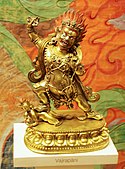Vadžrapáni
| Vadžrapáni | |
|---|---|
 Tibetská socha Vadžrapániho | |
| Sanskrt: | Vadžrapāṇi वज्रपाणि |
| Informace | |
| Výskyt: | mahájána, vadžrajána |
| Ztělesňuje: | Buddhovu sílu |
Vadžrapáni (skt; tibetsky Čhagna Dordže, česky. dosl. Držící diamant nebo hromoklín) je jeden z nejznámějších bódhisattvů v mahájánovém buddismu. Je ochránce a průvodce Buddhy a symbolizuje sílu realizace všech buddhů. V buddhistické ikonografii je Vadžrapáni často zobrazován s Avalókitéšvarou a Maňdžušrím, přičemž Avalókitéšvara zosobňuje Buddhův soucit, Maňdžušrí Buddhovu moudrost a Vadžrapáni právě jeho sílu.
Původ
Na nejstarších vyobrazeních je Vadžrapáni evropského (řeckého) vzhledu v podobě mocného siláka s atletickou postavou a dlouhým vousem, identifikován jako polobožský hrdina Héraklés, držící svůj atribut – typický kyj. Některým autorům předmět připomíná spíše hromoklín a přiklánějí se k tezi, že jde spíše o Dia. To podporuje indický učenec Buddhaghóša, který ztotožnil Vadžrapániho s jiným hromovládcem, indickým Indrou. Jisté je v obou případech, že na počátku vývoje této buddhistické postavy se podílely helénistické představy příchozích řeckých osadníků tvořících styl tzv. gandhárské neboli řecko-buddhistické umění.
Reference
V tomto článku byl použit překlad textu z článku Vajrapani na anglické Wikipedii.
Externí odkazy
 Obrázky, zvuky či videa k tématu Vadžrapáni na Wikimedia Commons
Obrázky, zvuky či videa k tématu Vadžrapáni na Wikimedia Commons
Média použitá na této stránce
Autor: Terren, Licence: CC BY 2.0
Vajrapani statue in American Museum of Natural History, New York
Autor: User:World Imaging, Licence: CC BY-SA 3.0
Panel showing the Buddha performing a miracle before ascetics. Kushan period, 2ndC-3rdC. Schist, H. 29,5 cm. (complete, here: partial view). « On the Buddha's left, Vajrapāṇi, with long, bearded face, modelled planes of musculature, genitals, a long draped overgarment from his left shoulder passing across the legs, holds a faceted vajra with rounded ends in his left hand and raises a fly-whisk like a torch in the right. » (Museum Collection on line) : This is a detail of a frieze regarding the conversion of three brothers to Buddhism. It is cropped to focus on the Buddha flanked by a figure of his guardian, Vajrapāṇi. [1]
In this image, Vajrapani is depicted in a more classically Grecian style than the surrounding figures, indicative of his cross-cultural status. Vajrapani is usually syncretized with Hercules,[2] but is also sometimes syncretized with Zeus. [3] (This particular piece could be understood either way)
In one hand Vajrapani carries a vajra (usually syncretized with Zeus' lightening and/or Hercules' sacred club) and in the other he brandishes a chamara, which is a fly-wisk symbolic of the sovereignty of the Buddha. [4]
References
- ↑ "On the Buddha's left, Vajrapāṇi, with long, bearded face, modelled planes of musculature, genitals, a long draped overgarment from his left shoulder passing across the legs, holds a faceted vajra with rounded ends in his left hand and raises a fly-whisk like a torch in the right." Panel #1961,0218.1. British Museum.[1]
- ↑ "Heracles became Vajrapani, guardian of Sakyamuni. There is a wealth of material and studies on the subject... to explain how Heracles went from being a purely classical Greek figure to being a guardian god in the Buddhist pantheon." HSING, I-TIEN, and WILLIAM G. CROWELL. “Heracles in the East: The Diffusion and Transformation of His Image in the Arts of Central Asia, India, and Medieval China.” Asia Major, vol. 18, no. 2, 2005, pp. 103–154. JSTOR, [www.jstor.org/stable/41649907]
- ↑ "In the art of Gandhara Zeus became the inseparable companion of the Buddha as Vajrapani." in Freedom, Progress, and Society, by K. Satchidananda Murty p.97
- ↑ The Handbook of Tibetan Buddhist Symbols p.177


